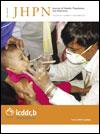Serological Analysis of Human Pandemic Influenza (H1N1) in Thailand
DOI:
https://doi.org/10.3329/jhpn.v28i6.6601Keywords:
H1N1, Influenza, Serodiagnosis, Surveillance, ThailandAbstract
The study was aimed at determining the prevalence of pandemic influenza (H1N1) 2009 among patients with respiratory tract diseases during July-December 2009 using real-time reverse transcription polymerase chain reaction. Haemagglutination inhibition (HI) assay was performed to detect antibody titres against pandemic influenza in 255 medical personnel, 307 members of the general population during the second week of December 2009 in Khon Kaen province, Thailand, and in 100 stored sera collected from people of different age-groups during 2008. The results showed that the pandemic (H1N1) 2009 had occurred during July-December 2009. The results of the HI test after the wave of this outbreak showed that 123 (48%) of the 255 sera collected from the medical personnel, 109 (36%) of the 307 sera obtained from the general population, and only two of the 100 stored sera from 2008 contained antibodies (HI titres ≥40) against pandemic influenza. Antibody against the pandemic (H1N1) 2009 was found in at least one-third of the population. In conclusion, the prevalence of virus and serological data obtained from the study can be used as the serological background level of the Thai population after the July-December pandemic. Finally, the serological data might be useful for outbreak-prevention and control strategies and for the management of vaccination for the pandemic (H1N1) 2009 in Thailand.Key words: H1N1; Influenza; Serodiagnosis; Surveillance; Thailand
DOI: 10.3329/jhpn.v28i6.6601
J HEALTH POPUL NUTR 2010 Dec;28(6):537-544
Downloads
Download data is not yet available.
Abstract
206
206
PDF
204
204
Downloads
How to Cite
Prachayangprecha, S., Makkoch, J., Payungporn, S., Chieochansin, T., Vuthitanachot, C., Vuthitanachot, V., … Poovoranwan, Y. (2010). Serological Analysis of Human Pandemic Influenza (H1N1) in Thailand. Journal of Health, Population and Nutrition, 28(6), 537–544. https://doi.org/10.3329/jhpn.v28i6.6601
Issue
Section
Original Papers

